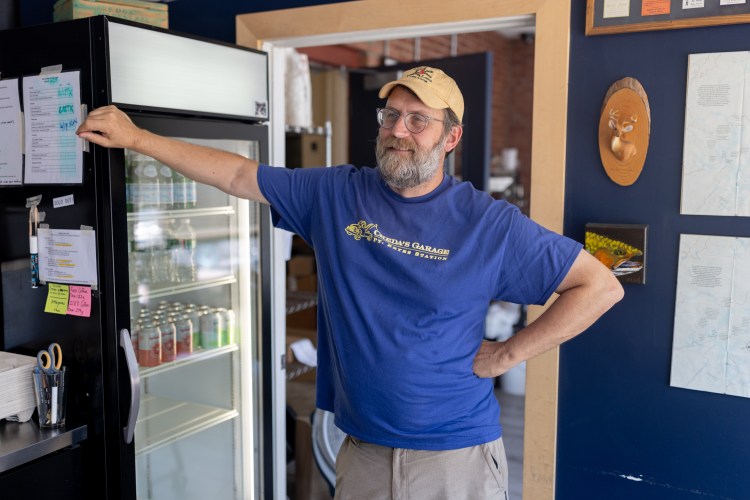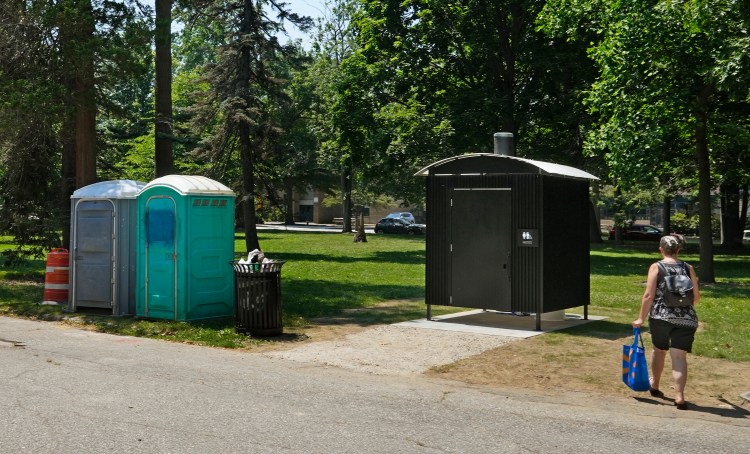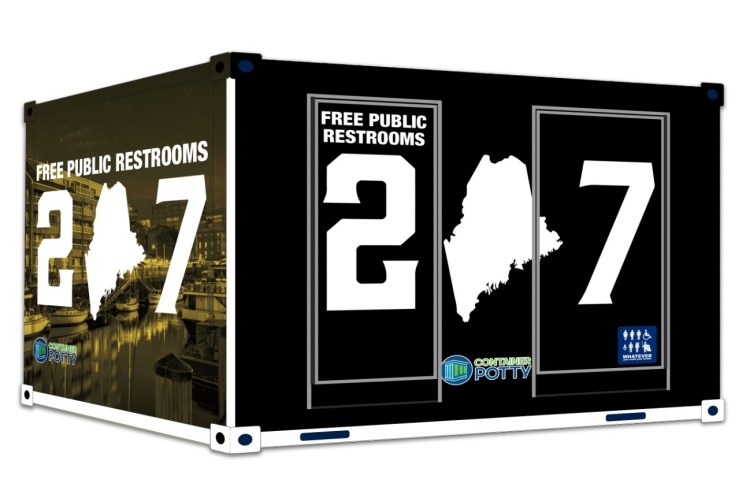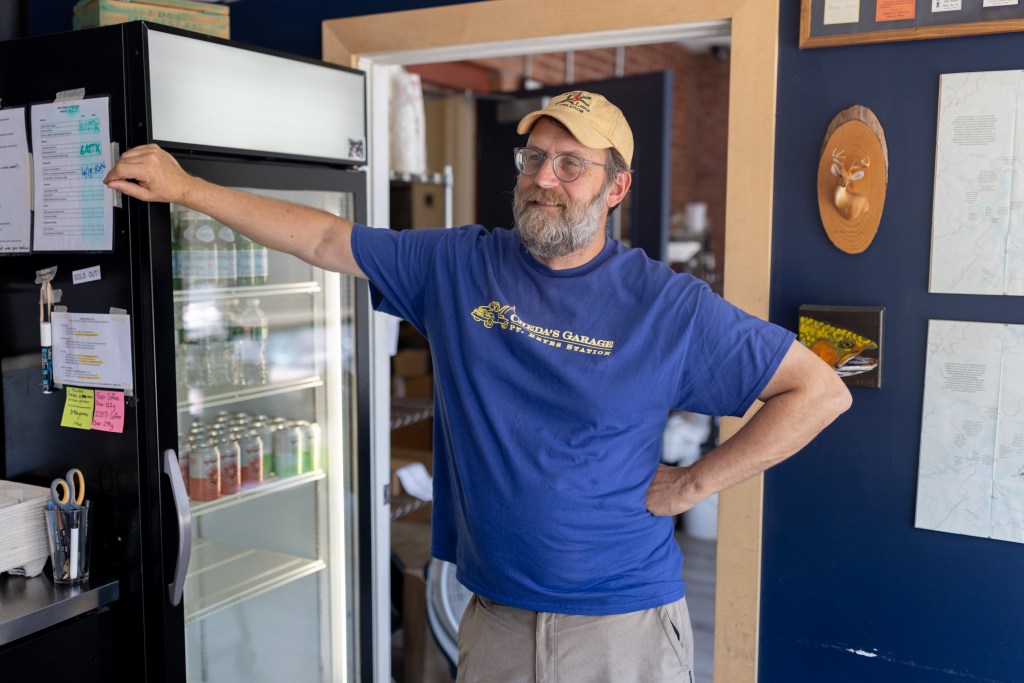
Matt Bolinder, owner of the Speckled Ax coffee shops in Portland, at his Walton Street roastery on Wednesday. Bolinder said the lack of public restrooms in Portland is an issue, especially for a city that depends so much on tourism. Brianna Soukup/Staff Photographer
Every day, someone will walk into Lisa-Marie’s Made in Maine in the Old Port and ask if there’s a bathroom they can use. Every day, Marie Stewart Harmon has to say no.
It’s the No. 1 question she gets from tourists and residents, she said, and it’s frustrating to hear they’d like to stay and shop, but they have to find a restroom.
“If you aren’t buying a beverage or eating a meal somewhere, the public restroom situation is pretty dire,” said Stewart Harmon, the general manager.
The lack of easily accessible public bathrooms has been a mounting problem in Portland for years. Recent efforts to add more semi-permanent toilets in the city have been promising and successful – a new one opened in Deering Oaks just this week – but business owners say it’s not enough.
“I can’t send the mom with three kids in tow to Deering Oaks,” Stewart Harmon said. The park is a 30-minute walk away. “That’s almost insulting.”
The city’s library and ferry terminal are the closest public restrooms to the gift shop, but even those take 10 minutes to get to. Often, the fastest bet is to go buy a beverage next door, she said, but she’s not a fan of the “pay to play” model.
A recent coronavirus-impact study from the Massachusetts Institute of Technology asked small companies in Portland about ongoing business and employment challenges, changes to their business processes and physical commercial spaces, and policy shifts that would be most helpful in aiding their post-pandemic recovery.
The key takeaway, according to the study’s authors, was a resounding call for more public restrooms downtown.
‘YES, YOU CAN PEE IN PORTLAND’
Cary Tyson isn’t surprised.
As the executive director of Portland Downtown, a nonprofit dedicated to promoting businesses and activities downtown, advocating for bathrooms has become a big part of his job.
And the problem has taken on a greater urgency since the pandemic.


The semi-permanent toilet, right, in Deering Oaks park was installed on Tuesday. It is one of 14 in the city, there are plans to add four more this year. Gregory Rec/Staff Photographer
“I can’t tell you the number of calls from business owners having to clear off urine or defecation (from their building),” he said. “I don’t think bathrooms are 100% going to solve that problem, but if the need arises and there’s no place to go, you’re not left with a lot of options.”
Portland Downtown launched a “Public Restroom Master Plan” this spring, aimed at making the city a more welcoming and equitable community – “One with a culture of ‘Yes, you can pee in Portland,’ ” Tyson said in announcing the plan. “It may sound silly, but it is important. … This restroom shortage is an issue of public health and as such, should be treated as one.”
Ultimately, the goal is to have a public toilet within a two- to three-minute walk from any given part of the city, though even five minutes would be an improvement, Tyson said. He estimated that could mean another eight established restrooms. Portland Downtown also hopes to increase signage so people know where they can find toilets.
“They talk about range anxiety with electric cars,” he said, and it’s the same with bathrooms.
“Geography is irrelevant to the human body,” he added.


An artist’s rendering of a two-stall public bathroom the nonprofit Portland Downtown wants to install in the city for part of the year. Courtesy of Portland Downtown
Portland Downtown plans to add a seasonal, temporary bathroom as a “learning laboratory” to eventually lead to permanent, plumbed and year-round restrooms.
A location has not yet been decided. Tyson said it would need to have frequent cleaning, so the organization plans to hire a third-party company to maintain it. Funds were built into the budget, he said, and they’re awaiting city approval.
BUSINESSES BECOMING THE DEFAULT
Matt Bolinder is sympathetic to people who come into Speckled Ax needing to use the restroom. It’s a situation everyone has been in at least once, he said.
Speckled Ax doesn’t require a purchase to use the bathroom – there’s no key or code to enter. But that also means that his two coffee shops on Congress and Thames streets often feel like default public restrooms.
“That feels like a bummer sometimes. Everything that we do costs money and has to be maintained,” he said. But he also knows that many people don’t have a better option.
It’s frustrating that a city so focused on tourism doesn’t have more bathrooms, especially brick-and-mortar places with running water and real toilets, he said.
Bolinder has noticed – and appreciates – the city’s recent effort to provide more bathrooms like porta potties and semi-permanent toilets around town, particularly as the unhoused population grows.
“But as far as actual restrooms go, it’s just sort of a shame and absurd that there aren’t more,” he said. “It should be something that the city provides … and not just expect us to (do) by letting people use our bathroom.”
Portland officials are working on it.
The city has so far installed 14 semi-permanent toilets, with four more in the works thanks to American Rescue Plan funds.
They’re simple in design, with no running water, which has kept the costs down to about $20,000 to $40,000 per unit, as opposed to around $500,000 for a brick-and-mortar restroom, said Jessica Grondin, city spokesperson. The bathrooms are cleaned twice per day and stocked with hand sanitizer, paper products and sharps collection containers.
There are a handful of flushable toilets at City Hall, Portland Public Library, Casco Bay Lines and the Troubh Ice Arena among other places.
Grondin said the city supports adding more. But the maintenance can be challenging, especially on the heavily used semi-permanent bathrooms.
PUMP OUT PROBLEMS
The vault-style toilets, which hold waste in a contained tank underground, need to be pumped out. Historically, that was done by contractors, but according to Grondin, the last two times they put the contract out to bid, they got no bidders.
“Based on feedback from prior contractors who performed this work, the condition of the units made it something they no longer wanted to do,” she said.
So the city is taking the reins and recently bought its own pump truck and hired additional staff to operate it.
“Having publicly available restrooms in our city is a key part of ensuring we continue to be an attractive place to visit,” Grondin said.
People ask to use the bathroom at Mainely Frames and Gallery multiple times a day, owner Leo Pelletier said. Options in the Arts District are few and far between.
“Sometimes you feel bad for them, they come in and have no place to go,” he said. “I can’t say no.”
But he’s also been burned before. Once someone came in and locked themselves in his bathroom for two hours. They only left after he threatened to call the police.
“There’s nothing around me at all,” he said. “They need to do something.”
Related Stories










